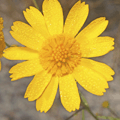
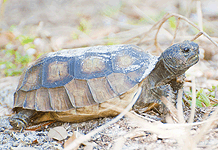
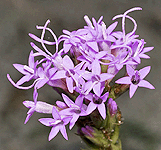
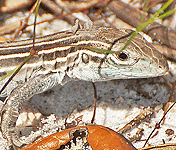
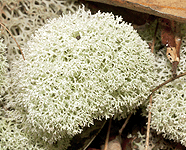
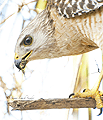
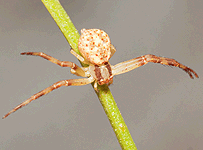
Secrets of the Scrub...
A Biodiversity Bonanza
Christopher B. Smith Preserve Field Guide
Secrets of the Scrub... A Biodiversity Bonanza Christopher B. Smith Preserve Field Guide |
So much life in such a very special place!
Packed into 7.5 acres that border the urban interface of Naples, Florida, the Christopher B. Smith Preserve at the Conservancy of Southwest Florida Nature Center is teeming with life. The diversity of species and the number of individuals are truly amazing.
The embedded "YouTube" movie below, lasting 4:42 minutes, shows sights in the Christopher B. Smith Preserve. The accompanying song, "Celebrating Life" is an original work by Wayne Peppercorn. The composition was specifically designed for this presentation.
Click here for a link to the "YouTube" page.
This special place has a very long history, available to read at a click of your mouse. Today, this area is a preserve for the threatened Gopher Tortoise (Gopherus polyphemus).
Gopherus polyphemus is the only native North American tortoise native to areas east of the Mississippi River. Found in six states including Louisiana, Mississippi, Alabama, South Carolina, Georgia, and Florida, the largest numbers are in Florida where they are found in all 67 counties. These tortoises inhabit uplands with deep well-drained sandy soil and xeric (desert-like) conditions, like the environment that exists at the Preserve. Click here or on the tortoise photograph to learn more about the gopher tortoises in the Smith Preserve.
A secret in the city!
Adjacent to a busy street (Goodlette - Frank Road), the Smith Preserve, like other scrub lands, consists of small trees that thrive in a xeric habitat. Google Earth maps below show the location of the Christopher B. Smith Preserve within the Naples, Florida City Limits. Map details increase as you move from left to right. Click on the maps to enlarge the images.
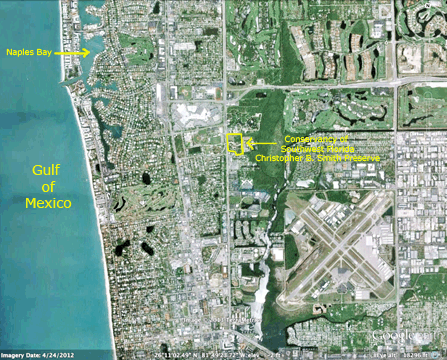
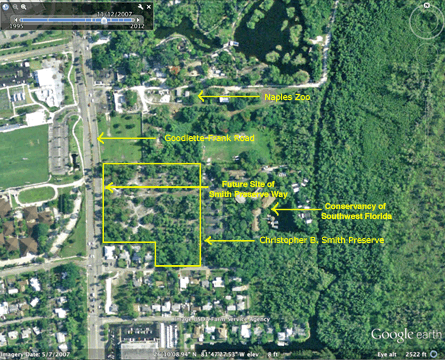
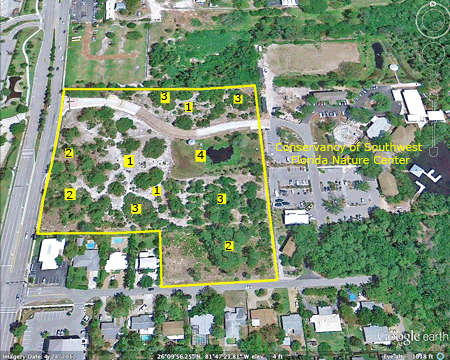
Tucked within the boundaries of the Smith Preserve are four ecosystems: 1) Oak-Rosemary Scrub, 2) Pine Flatwoods, 3) Tropical Hardwood Hammock, and 4) Marsh. The Google Earth map at left shows the location of these ecosystems within the Preserve. Click on the map to see an enlarged image.
As seen in the photographs below, each ecosystem has its own dominant plant species. By rolling your cursor over the first photograph, you will observe the distinct differences in vegetation during the summer and winter seasons in the Oak-Rosemary Scrub. Please note: this website feature will work on computers but not on cell phones. Although seasonal changes occur in the other ecosystems too, the differences are not as extreme and there are no rollover images.
1) Oak-Rosemary Scrub: The central portion of the Smith Preserve, observed from the elevated road, is an oak-rosemary scrub. The soil has little or no horizontal development, is well drained, and has low nutrient content. It is sand, littered with oak leaves and peppered with a unique biological soil crust and Opuntia humifusa (Prickly-Pear Cactus). It is a harsh environment with hotter temperatures than other ecosystems in the Preserve. Water from rainfall sinks quickly between the sand grains. Winds blow the sand and abrade and bury small plants.
Most scrub plants have shallow root systems to take advantage of water provided by condensation and brief thunderstorms. Many plants have waxy coatings, curled leaves (like the Sand Live Oaks in the photograph top right), or needle-like leaves (like the Florida Rosemary shown at bottom right) to prevent water loss by evaporation. Animals withstand heat and drought through behavioral and physiological adaptations. In spite of the harsh conditions, scrub sites of a few acres or more are thought to support several thousand species of insects and spiders. An estimated 40-60% of scrub species are endemic, which means they are restricted to this habitat. Historically, lightning has been the source of fire in scrub ecosystems with natural burns occurring every 30 to 70 years. After a fire, scrub plants re-sprout from roots or germinate from seeds trapped in the sand. Without fire, scrub plants are slowly replaced by other species. Florida scrub is one of the oldest and most endangered natural plant communities in the United States. All scrub communities are listed on the Florida Natural Area Inventory as imperiled, most due to urban encroachment.
2) Pine Flatwoods: The western portion of the Smith Preserve that borders Goodlette - Frank Road and the southeastern portion of the Smith Preserve that borders 14th Ave are pine flatwoods. This ecosystem consists of an overstory of slash pines and an understory of oaks, shrubs, and saw palmetto (shown at right). The soil is well-drained, sandy, and nutrient-poor. Pine needles litter the area and help retain moisture. Historically, pine uplands are normally maintained by lightning-started fires. Fire causes slash pines to release seeds from their cones and saw palmetto to develop new growth from their subterranean trunks.
3) Tropical Hardwood Hammock: Tropical hardwood hammocks are located in the northern border and southeastern corner of the Smith Preserve as well as in an area south of the elevated road and east of the pine flatwoods area. These hammocks consist of large oak and sable palm overstory and shrub, fern, and vine understory. Epiphytes, like the one pictured here, are abundant in the trees. The soil is littered with leaves and decomposing vegetation. When compared to the scrub, hammocks have more shade, cooler temperature, higher humidity, and more fertile soil.
4) Marsh: Since the land was purchased through generous gifts to the Conservancy "Saving Southwest Florida" campaign, the pond has been converted into two marshes separated by a berm. The more western marsh floods in the summer and dries in the winter. It is dominated by grasses, rushes, and sedges. The more eastern marsh has water year-round. Its periphery is pickerelweed, fire flag, string lilies, leatherfern (shown at right), and small trees. Spadderdock leaves float on the water surface. These marshes provide feeding areas for wading birds and habitat for dragonflies, fish, turtles, and frogs. Both marshes filter runoff from the surrounding urban community.
Roll your cursor over the photograph of the red shouldered hawk to see another animal.
Every organism plays a vital role in the health of the Smith Preserve. Plants use water, carbon dioxide and soil nutrients to create food for the animals. Lichens help clean the air by removing air pollutants. Insects pollinate the flowers and provide nutrients for predators. Birds and mammals distribute plant seeds, keep populations of other organisms in check (eg. the red-shouldered hawk shown above ), and are food for predators. Scavengers remove excreted wastes and dead organisms. Microorganisms and fungi decompose organic matter and release nutrients. Burrowing insects, reptiles, and mammals mix these nutrients into the soil. Removing any group of organisms from the Smith Preserve would be detrimental to the balance that exists.
Monitoring Details: The more than ~50 gopher tortoises living in the Smith Preserve are only one of the hundreds of species being monitored and protected by the Science Division at the Conservancy of Southwest Florida. One of the functions of the Conservancy Science Division is to inventory the species of organisms that live in the Smith Preserve.
Roll your cursor over the photograph above for another scene.
The "Inventory of Organisms" below links to photographs and descriptions of more than 1300 species in Smith Preserve. While some of the organisms are permanent residents and others are visitors, every photograph was taken in the Smith Preserve.
Enjoy your virtual experience getting to know the various "players" in this incredible special place. Click on organism names or photographs below and begin your adventure!
_____________________________________________
Inventory of Organisms
Total Posted 1327 Species
I I. Kingdom Monera (Prokaryotes)
A. Domain Bacteria (1 species)
A. Fungi (28 species)
B. Lichens (23 species)
III. Kingdom Plantae (9 Phyla/ Divisions)
A. Chlorophytes (Algae) (2 species)
B. Bryophytes (Mosses) (2 species)
C. Hepatophytes (Liverworts) (2 species)
D. Lycopodiophytes (Club Mosses) (1 species)
E. Psilophytes (Whisk Ferns) (1 species)
F. Pteridophytes (Ferns) (9 species)
G. Cycadophytes (Cycads) (2 species)
H. Coniferophytes (Conifers) (2 species)
I. Magnoliophytes (Flowering Plants) (228 species)
IV. Kingdom Animalia (6 Phyla)
A. Phylum Platyhelminthes (Flatworms) (1 species)
B. Phylum Nematoda / Nemata (Roundworms, Threadworms) (1 species)
C. Phylum Tardigrada (1 species)
D. Phylum Mollusca (Clams, Snails) (6 species)
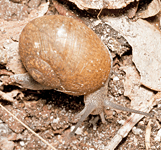
E. Phylum Arthropoda
i. Subphylum Chelicerata
a. Class Arachnida (Spiders, Mites, Pseudoscorpions) (148 species)
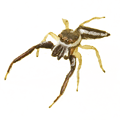
ii. Subphylum Crustacea
a. Class Branchiopoda (Water Fleas) (1 species)
b. Class Ostracoda (Seed Shrimp) (1 species)
c. Class Malacostraca (Shrimp and Woodlice) (2 species)
iii. Subphylum Hexapoda
a. Class Diplura (Dipluran) (1 species)
b. Class Collembola (Springtails) (53 species)
c. Class Insecta (712 species)
iv. Subphylum Myriapoda
a. Class Chilopoda (Centipedes) (3 species)
b. Class Diplopoda (Millipedes) (8 species)
F. Phylum Chordata
i. Subphylum Vertebrata
a. Class Osteichthyes (Fish) (9 species)
b. Class Amphibia (Frogs, Toads)(3 species)
c. Class Reptilia (Snakes, Lizards, Turtles, Tortoises)(18 species)
d. Class Aves (Birds) (35 species)
e. Class Mammalia (13 species)
© 2013- 2025
Photographs and text are by Susan Leach Snyder (Conservancy of Southwest Florida Volunteer), unless otherwise credited.
Link to: Conservancy of Southwest Florida Home Page.
Please report errors to Susan Snyder: